Comprehensive Discharge and Self-Management Plan for Colorectal Cancer
VerifiedAdded on 2023/06/11
|8
|2347
|482
Report
AI Summary
This report outlines a discharge and self-management plan for Harold, a 65-year-old patient diagnosed with colorectal cancer. The plan addresses key aspects of post-operative care, focusing on empowering Harold to manage his condition at home. It emphasizes a multidisciplinary approach involving surgeons, social workers, counselors, oncologists, nurses, and physicians. The plan includes educating Harold about the potential recurrence of colorectal cancer, including signs and symptoms, and providing strategies for self-management, such as medication compliance, dietary adjustments, physical activity, and maintaining healthy sleep patterns. Furthermore, it highlights the importance of addressing Harold's spiritual, social, and psychological well-being through collaboration with family members, counselors, and peer support groups. The report also details strategies to facilitate effective patient education, including the use of strong communication skills and a learner-centered teaching approach to ensure Harold is well-equipped to manage his health and recovery effectively. Desklib provides access to a wide range of study tools and solved assignments for students.
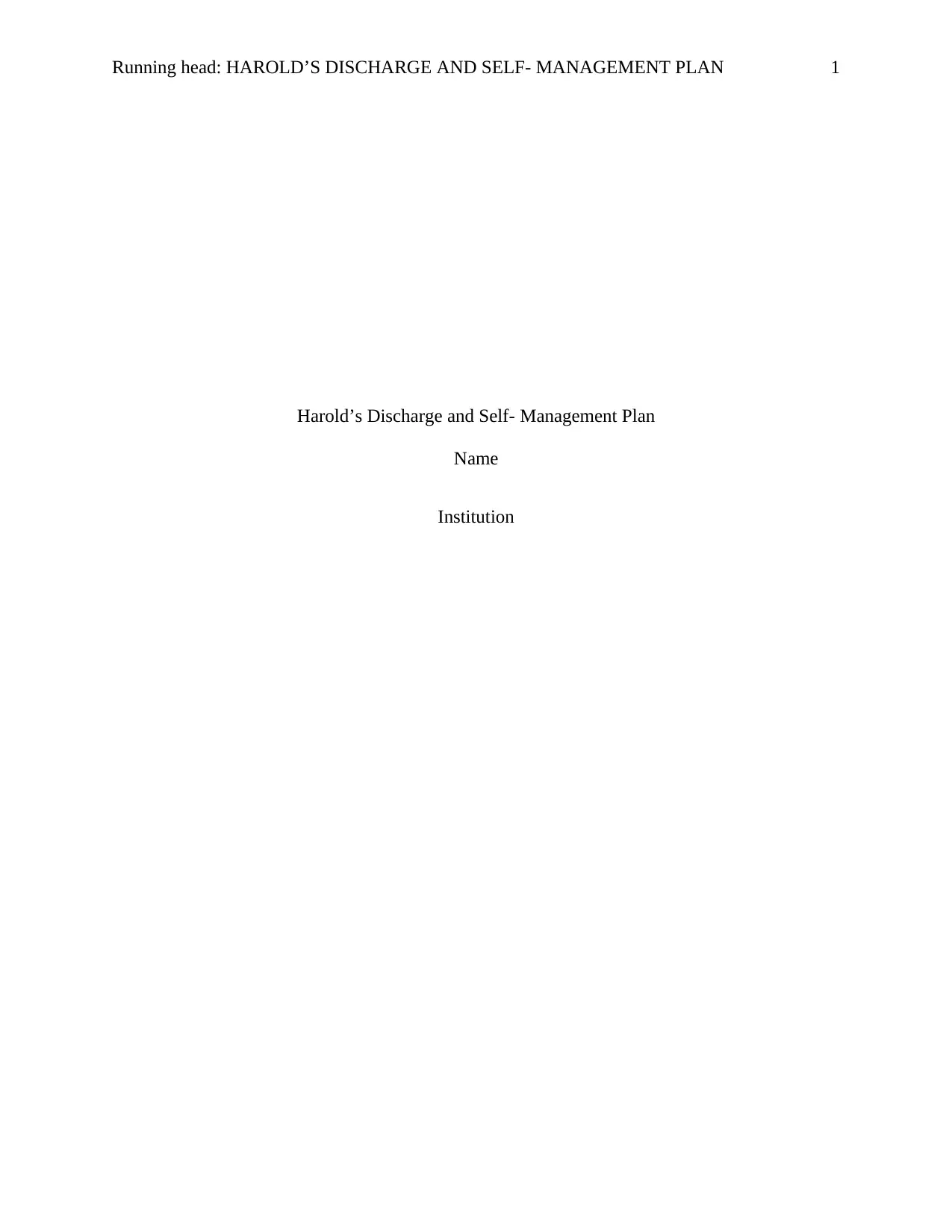
Running head: HAROLD’S DISCHARGE AND SELF- MANAGEMENT PLAN 1
Harold’s Discharge and Self- Management Plan
Name
Institution
Harold’s Discharge and Self- Management Plan
Name
Institution
Paraphrase This Document
Need a fresh take? Get an instant paraphrase of this document with our AI Paraphraser
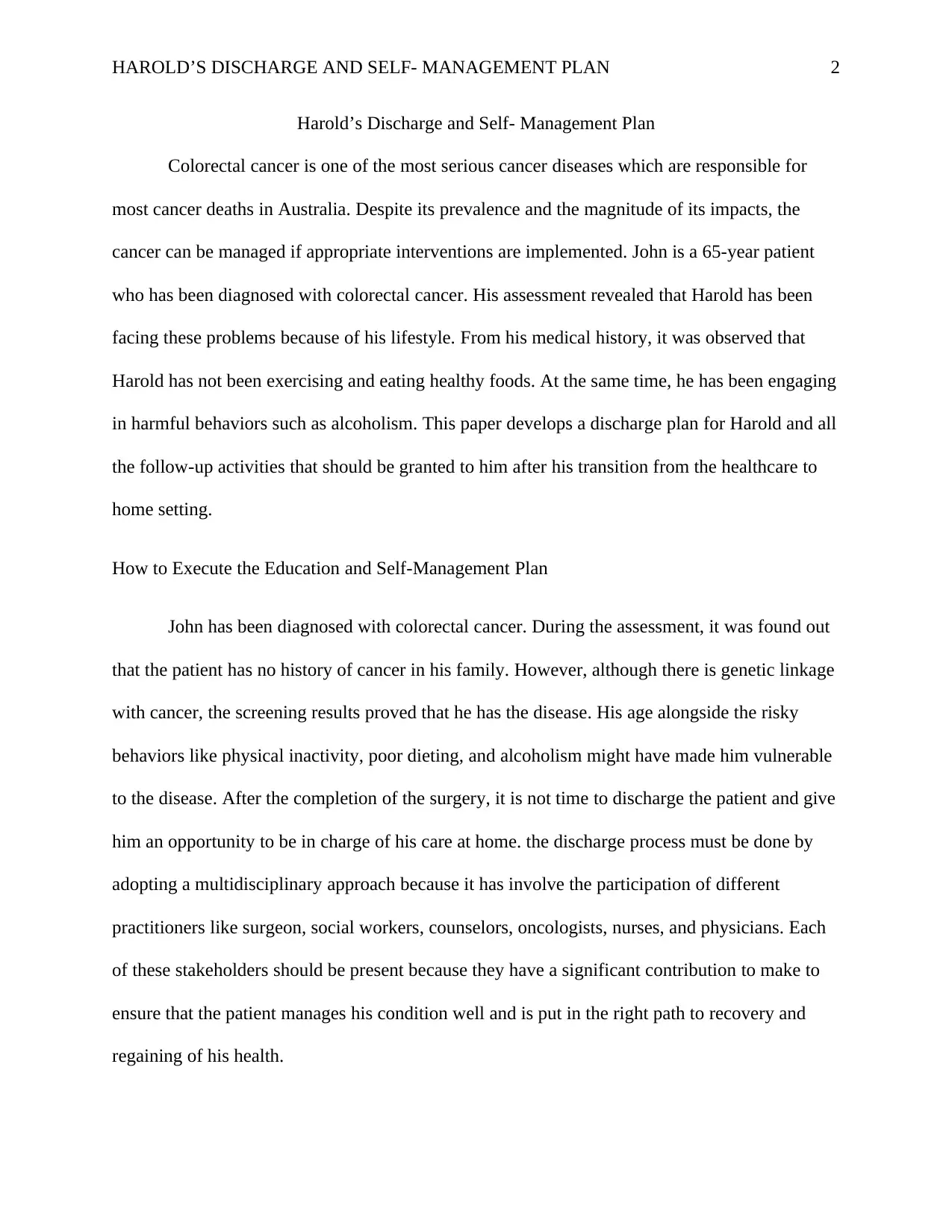
HAROLD’S DISCHARGE AND SELF- MANAGEMENT PLAN 2
Harold’s Discharge and Self- Management Plan
Colorectal cancer is one of the most serious cancer diseases which are responsible for
most cancer deaths in Australia. Despite its prevalence and the magnitude of its impacts, the
cancer can be managed if appropriate interventions are implemented. John is a 65-year patient
who has been diagnosed with colorectal cancer. His assessment revealed that Harold has been
facing these problems because of his lifestyle. From his medical history, it was observed that
Harold has not been exercising and eating healthy foods. At the same time, he has been engaging
in harmful behaviors such as alcoholism. This paper develops a discharge plan for Harold and all
the follow-up activities that should be granted to him after his transition from the healthcare to
home setting.
How to Execute the Education and Self-Management Plan
John has been diagnosed with colorectal cancer. During the assessment, it was found out
that the patient has no history of cancer in his family. However, although there is genetic linkage
with cancer, the screening results proved that he has the disease. His age alongside the risky
behaviors like physical inactivity, poor dieting, and alcoholism might have made him vulnerable
to the disease. After the completion of the surgery, it is not time to discharge the patient and give
him an opportunity to be in charge of his care at home. the discharge process must be done by
adopting a multidisciplinary approach because it has involve the participation of different
practitioners like surgeon, social workers, counselors, oncologists, nurses, and physicians. Each
of these stakeholders should be present because they have a significant contribution to make to
ensure that the patient manages his condition well and is put in the right path to recovery and
regaining of his health.
Harold’s Discharge and Self- Management Plan
Colorectal cancer is one of the most serious cancer diseases which are responsible for
most cancer deaths in Australia. Despite its prevalence and the magnitude of its impacts, the
cancer can be managed if appropriate interventions are implemented. John is a 65-year patient
who has been diagnosed with colorectal cancer. His assessment revealed that Harold has been
facing these problems because of his lifestyle. From his medical history, it was observed that
Harold has not been exercising and eating healthy foods. At the same time, he has been engaging
in harmful behaviors such as alcoholism. This paper develops a discharge plan for Harold and all
the follow-up activities that should be granted to him after his transition from the healthcare to
home setting.
How to Execute the Education and Self-Management Plan
John has been diagnosed with colorectal cancer. During the assessment, it was found out
that the patient has no history of cancer in his family. However, although there is genetic linkage
with cancer, the screening results proved that he has the disease. His age alongside the risky
behaviors like physical inactivity, poor dieting, and alcoholism might have made him vulnerable
to the disease. After the completion of the surgery, it is not time to discharge the patient and give
him an opportunity to be in charge of his care at home. the discharge process must be done by
adopting a multidisciplinary approach because it has involve the participation of different
practitioners like surgeon, social workers, counselors, oncologists, nurses, and physicians. Each
of these stakeholders should be present because they have a significant contribution to make to
ensure that the patient manages his condition well and is put in the right path to recovery and
regaining of his health.
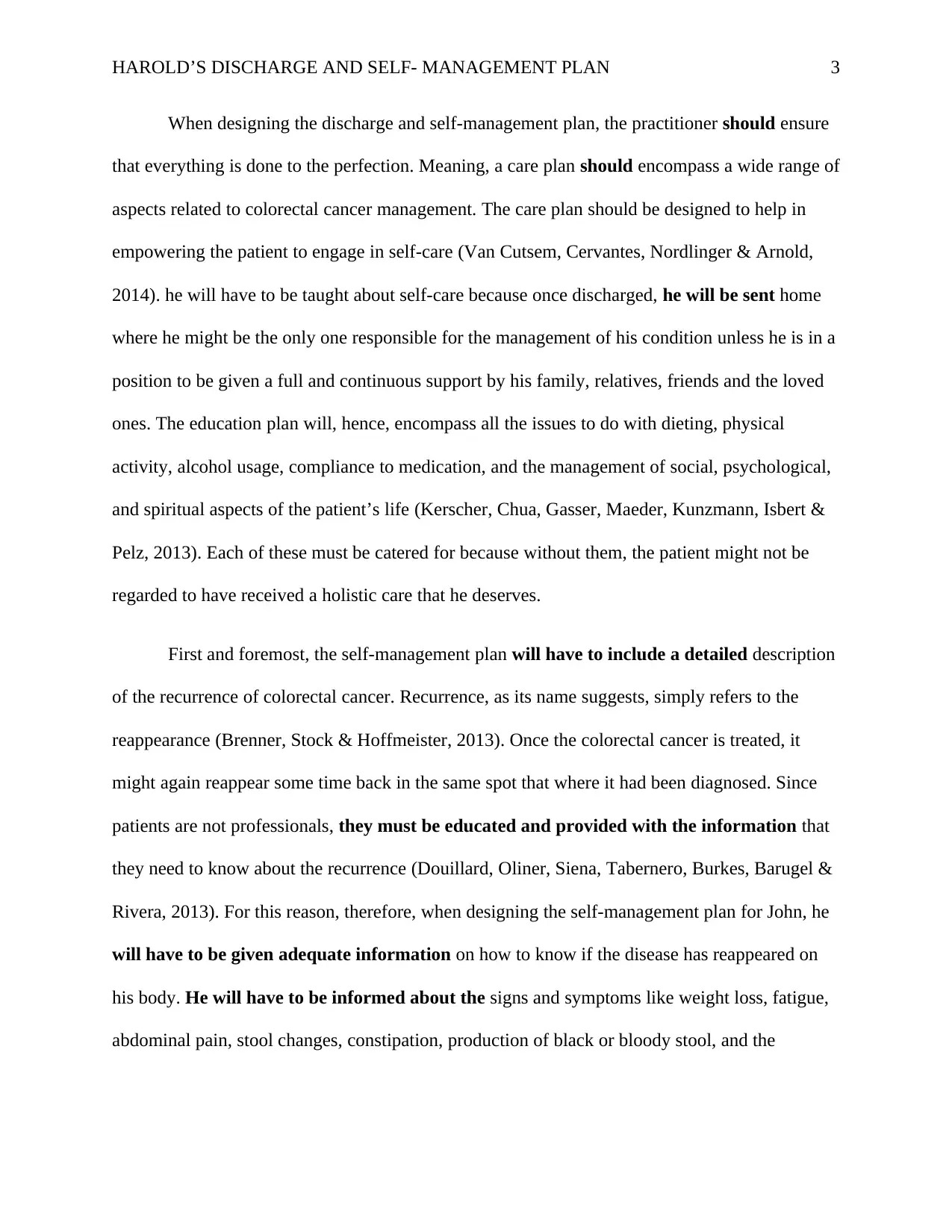
HAROLD’S DISCHARGE AND SELF- MANAGEMENT PLAN 3
When designing the discharge and self-management plan, the practitioner should ensure
that everything is done to the perfection. Meaning, a care plan should encompass a wide range of
aspects related to colorectal cancer management. The care plan should be designed to help in
empowering the patient to engage in self-care (Van Cutsem, Cervantes, Nordlinger & Arnold,
2014). he will have to be taught about self-care because once discharged, he will be sent home
where he might be the only one responsible for the management of his condition unless he is in a
position to be given a full and continuous support by his family, relatives, friends and the loved
ones. The education plan will, hence, encompass all the issues to do with dieting, physical
activity, alcohol usage, compliance to medication, and the management of social, psychological,
and spiritual aspects of the patient’s life (Kerscher, Chua, Gasser, Maeder, Kunzmann, Isbert &
Pelz, 2013). Each of these must be catered for because without them, the patient might not be
regarded to have received a holistic care that he deserves.
First and foremost, the self-management plan will have to include a detailed description
of the recurrence of colorectal cancer. Recurrence, as its name suggests, simply refers to the
reappearance (Brenner, Stock & Hoffmeister, 2013). Once the colorectal cancer is treated, it
might again reappear some time back in the same spot that where it had been diagnosed. Since
patients are not professionals, they must be educated and provided with the information that
they need to know about the recurrence (Douillard, Oliner, Siena, Tabernero, Burkes, Barugel &
Rivera, 2013). For this reason, therefore, when designing the self-management plan for John, he
will have to be given adequate information on how to know if the disease has reappeared on
his body. He will have to be informed about the signs and symptoms like weight loss, fatigue,
abdominal pain, stool changes, constipation, production of black or bloody stool, and the
When designing the discharge and self-management plan, the practitioner should ensure
that everything is done to the perfection. Meaning, a care plan should encompass a wide range of
aspects related to colorectal cancer management. The care plan should be designed to help in
empowering the patient to engage in self-care (Van Cutsem, Cervantes, Nordlinger & Arnold,
2014). he will have to be taught about self-care because once discharged, he will be sent home
where he might be the only one responsible for the management of his condition unless he is in a
position to be given a full and continuous support by his family, relatives, friends and the loved
ones. The education plan will, hence, encompass all the issues to do with dieting, physical
activity, alcohol usage, compliance to medication, and the management of social, psychological,
and spiritual aspects of the patient’s life (Kerscher, Chua, Gasser, Maeder, Kunzmann, Isbert &
Pelz, 2013). Each of these must be catered for because without them, the patient might not be
regarded to have received a holistic care that he deserves.
First and foremost, the self-management plan will have to include a detailed description
of the recurrence of colorectal cancer. Recurrence, as its name suggests, simply refers to the
reappearance (Brenner, Stock & Hoffmeister, 2013). Once the colorectal cancer is treated, it
might again reappear some time back in the same spot that where it had been diagnosed. Since
patients are not professionals, they must be educated and provided with the information that
they need to know about the recurrence (Douillard, Oliner, Siena, Tabernero, Burkes, Barugel &
Rivera, 2013). For this reason, therefore, when designing the self-management plan for John, he
will have to be given adequate information on how to know if the disease has reappeared on
his body. He will have to be informed about the signs and symptoms like weight loss, fatigue,
abdominal pain, stool changes, constipation, production of black or bloody stool, and the
⊘ This is a preview!⊘
Do you want full access?
Subscribe today to unlock all pages.

Trusted by 1+ million students worldwide
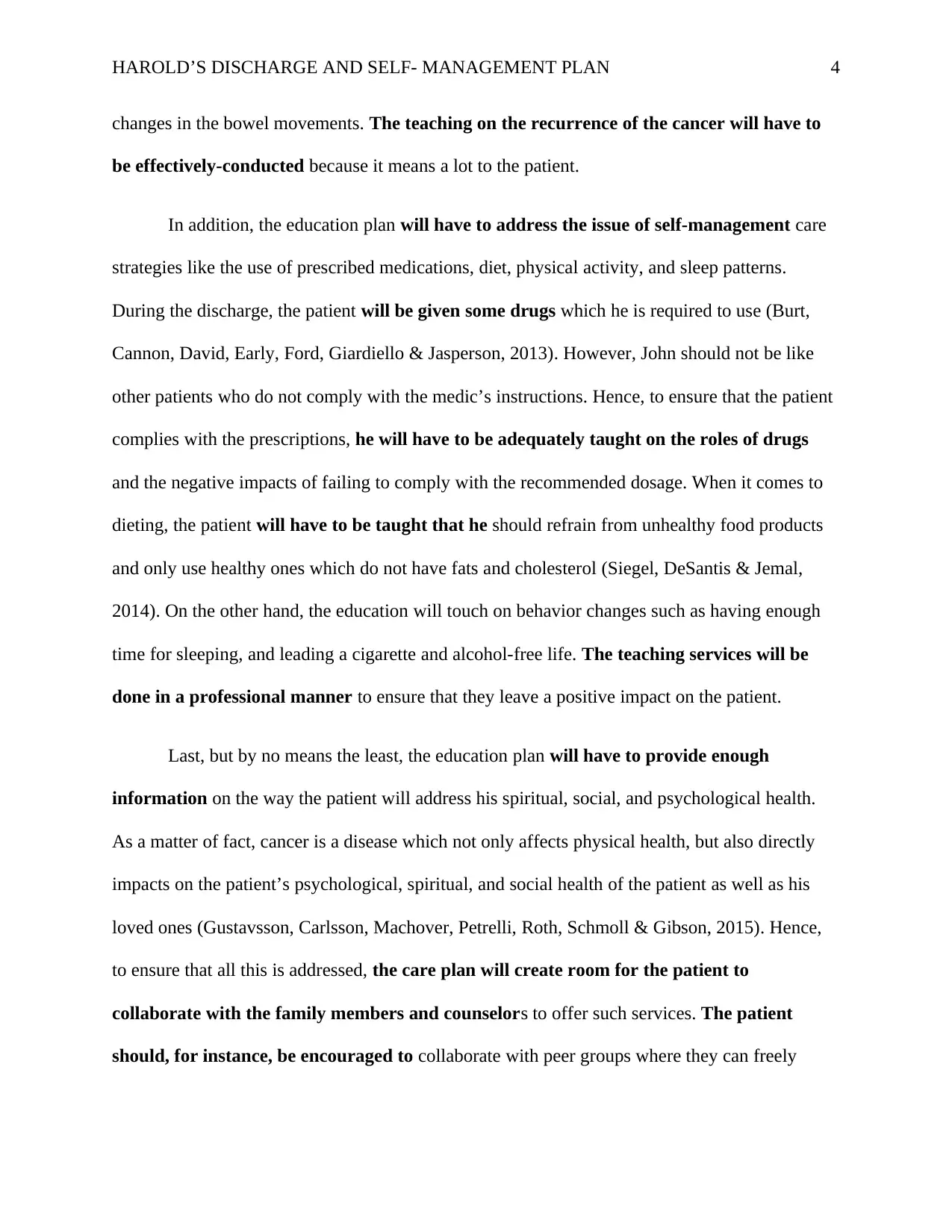
HAROLD’S DISCHARGE AND SELF- MANAGEMENT PLAN 4
changes in the bowel movements. The teaching on the recurrence of the cancer will have to
be effectively-conducted because it means a lot to the patient.
In addition, the education plan will have to address the issue of self-management care
strategies like the use of prescribed medications, diet, physical activity, and sleep patterns.
During the discharge, the patient will be given some drugs which he is required to use (Burt,
Cannon, David, Early, Ford, Giardiello & Jasperson, 2013). However, John should not be like
other patients who do not comply with the medic’s instructions. Hence, to ensure that the patient
complies with the prescriptions, he will have to be adequately taught on the roles of drugs
and the negative impacts of failing to comply with the recommended dosage. When it comes to
dieting, the patient will have to be taught that he should refrain from unhealthy food products
and only use healthy ones which do not have fats and cholesterol (Siegel, DeSantis & Jemal,
2014). On the other hand, the education will touch on behavior changes such as having enough
time for sleeping, and leading a cigarette and alcohol-free life. The teaching services will be
done in a professional manner to ensure that they leave a positive impact on the patient.
Last, but by no means the least, the education plan will have to provide enough
information on the way the patient will address his spiritual, social, and psychological health.
As a matter of fact, cancer is a disease which not only affects physical health, but also directly
impacts on the patient’s psychological, spiritual, and social health of the patient as well as his
loved ones (Gustavsson, Carlsson, Machover, Petrelli, Roth, Schmoll & Gibson, 2015). Hence,
to ensure that all this is addressed, the care plan will create room for the patient to
collaborate with the family members and counselors to offer such services. The patient
should, for instance, be encouraged to collaborate with peer groups where they can freely
changes in the bowel movements. The teaching on the recurrence of the cancer will have to
be effectively-conducted because it means a lot to the patient.
In addition, the education plan will have to address the issue of self-management care
strategies like the use of prescribed medications, diet, physical activity, and sleep patterns.
During the discharge, the patient will be given some drugs which he is required to use (Burt,
Cannon, David, Early, Ford, Giardiello & Jasperson, 2013). However, John should not be like
other patients who do not comply with the medic’s instructions. Hence, to ensure that the patient
complies with the prescriptions, he will have to be adequately taught on the roles of drugs
and the negative impacts of failing to comply with the recommended dosage. When it comes to
dieting, the patient will have to be taught that he should refrain from unhealthy food products
and only use healthy ones which do not have fats and cholesterol (Siegel, DeSantis & Jemal,
2014). On the other hand, the education will touch on behavior changes such as having enough
time for sleeping, and leading a cigarette and alcohol-free life. The teaching services will be
done in a professional manner to ensure that they leave a positive impact on the patient.
Last, but by no means the least, the education plan will have to provide enough
information on the way the patient will address his spiritual, social, and psychological health.
As a matter of fact, cancer is a disease which not only affects physical health, but also directly
impacts on the patient’s psychological, spiritual, and social health of the patient as well as his
loved ones (Gustavsson, Carlsson, Machover, Petrelli, Roth, Schmoll & Gibson, 2015). Hence,
to ensure that all this is addressed, the care plan will create room for the patient to
collaborate with the family members and counselors to offer such services. The patient
should, for instance, be encouraged to collaborate with peer groups where they can freely
Paraphrase This Document
Need a fresh take? Get an instant paraphrase of this document with our AI Paraphraser
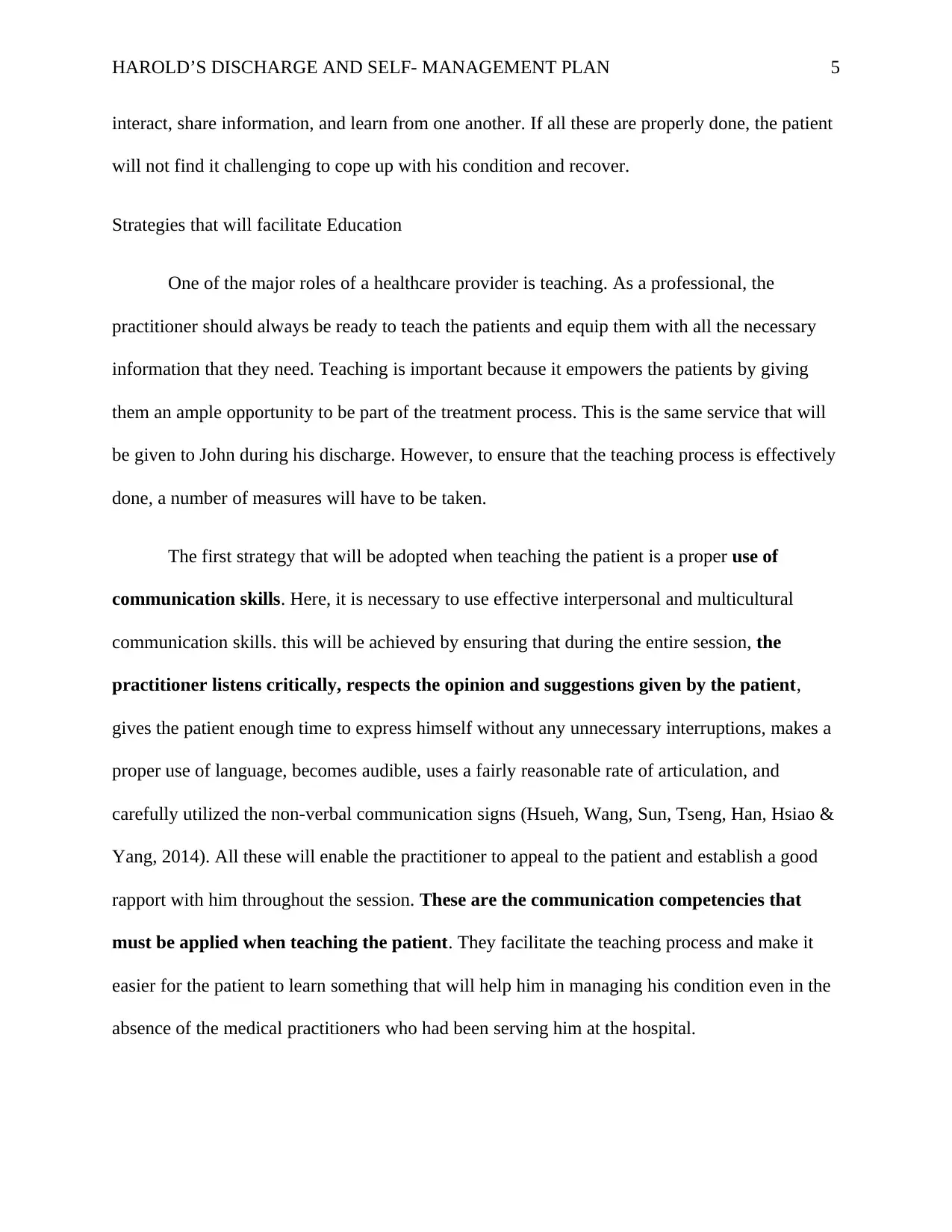
HAROLD’S DISCHARGE AND SELF- MANAGEMENT PLAN 5
interact, share information, and learn from one another. If all these are properly done, the patient
will not find it challenging to cope up with his condition and recover.
Strategies that will facilitate Education
One of the major roles of a healthcare provider is teaching. As a professional, the
practitioner should always be ready to teach the patients and equip them with all the necessary
information that they need. Teaching is important because it empowers the patients by giving
them an ample opportunity to be part of the treatment process. This is the same service that will
be given to John during his discharge. However, to ensure that the teaching process is effectively
done, a number of measures will have to be taken.
The first strategy that will be adopted when teaching the patient is a proper use of
communication skills. Here, it is necessary to use effective interpersonal and multicultural
communication skills. this will be achieved by ensuring that during the entire session, the
practitioner listens critically, respects the opinion and suggestions given by the patient,
gives the patient enough time to express himself without any unnecessary interruptions, makes a
proper use of language, becomes audible, uses a fairly reasonable rate of articulation, and
carefully utilized the non-verbal communication signs (Hsueh, Wang, Sun, Tseng, Han, Hsiao &
Yang, 2014). All these will enable the practitioner to appeal to the patient and establish a good
rapport with him throughout the session. These are the communication competencies that
must be applied when teaching the patient. They facilitate the teaching process and make it
easier for the patient to learn something that will help him in managing his condition even in the
absence of the medical practitioners who had been serving him at the hospital.
interact, share information, and learn from one another. If all these are properly done, the patient
will not find it challenging to cope up with his condition and recover.
Strategies that will facilitate Education
One of the major roles of a healthcare provider is teaching. As a professional, the
practitioner should always be ready to teach the patients and equip them with all the necessary
information that they need. Teaching is important because it empowers the patients by giving
them an ample opportunity to be part of the treatment process. This is the same service that will
be given to John during his discharge. However, to ensure that the teaching process is effectively
done, a number of measures will have to be taken.
The first strategy that will be adopted when teaching the patient is a proper use of
communication skills. Here, it is necessary to use effective interpersonal and multicultural
communication skills. this will be achieved by ensuring that during the entire session, the
practitioner listens critically, respects the opinion and suggestions given by the patient,
gives the patient enough time to express himself without any unnecessary interruptions, makes a
proper use of language, becomes audible, uses a fairly reasonable rate of articulation, and
carefully utilized the non-verbal communication signs (Hsueh, Wang, Sun, Tseng, Han, Hsiao &
Yang, 2014). All these will enable the practitioner to appeal to the patient and establish a good
rapport with him throughout the session. These are the communication competencies that
must be applied when teaching the patient. They facilitate the teaching process and make it
easier for the patient to learn something that will help him in managing his condition even in the
absence of the medical practitioners who had been serving him at the hospital.
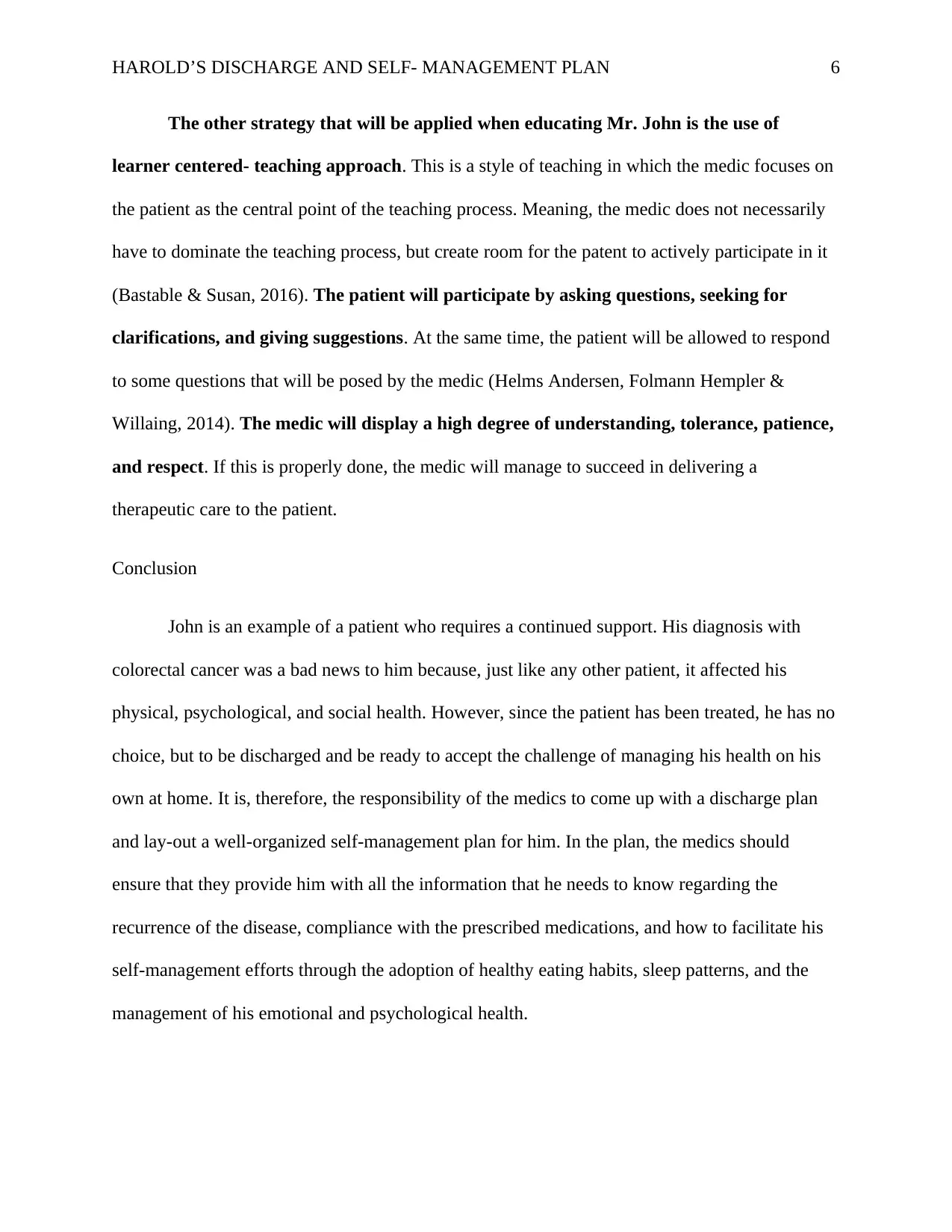
HAROLD’S DISCHARGE AND SELF- MANAGEMENT PLAN 6
The other strategy that will be applied when educating Mr. John is the use of
learner centered- teaching approach. This is a style of teaching in which the medic focuses on
the patient as the central point of the teaching process. Meaning, the medic does not necessarily
have to dominate the teaching process, but create room for the patent to actively participate in it
(Bastable & Susan, 2016). The patient will participate by asking questions, seeking for
clarifications, and giving suggestions. At the same time, the patient will be allowed to respond
to some questions that will be posed by the medic (Helms Andersen, Folmann Hempler &
Willaing, 2014). The medic will display a high degree of understanding, tolerance, patience,
and respect. If this is properly done, the medic will manage to succeed in delivering a
therapeutic care to the patient.
Conclusion
John is an example of a patient who requires a continued support. His diagnosis with
colorectal cancer was a bad news to him because, just like any other patient, it affected his
physical, psychological, and social health. However, since the patient has been treated, he has no
choice, but to be discharged and be ready to accept the challenge of managing his health on his
own at home. It is, therefore, the responsibility of the medics to come up with a discharge plan
and lay-out a well-organized self-management plan for him. In the plan, the medics should
ensure that they provide him with all the information that he needs to know regarding the
recurrence of the disease, compliance with the prescribed medications, and how to facilitate his
self-management efforts through the adoption of healthy eating habits, sleep patterns, and the
management of his emotional and psychological health.
The other strategy that will be applied when educating Mr. John is the use of
learner centered- teaching approach. This is a style of teaching in which the medic focuses on
the patient as the central point of the teaching process. Meaning, the medic does not necessarily
have to dominate the teaching process, but create room for the patent to actively participate in it
(Bastable & Susan, 2016). The patient will participate by asking questions, seeking for
clarifications, and giving suggestions. At the same time, the patient will be allowed to respond
to some questions that will be posed by the medic (Helms Andersen, Folmann Hempler &
Willaing, 2014). The medic will display a high degree of understanding, tolerance, patience,
and respect. If this is properly done, the medic will manage to succeed in delivering a
therapeutic care to the patient.
Conclusion
John is an example of a patient who requires a continued support. His diagnosis with
colorectal cancer was a bad news to him because, just like any other patient, it affected his
physical, psychological, and social health. However, since the patient has been treated, he has no
choice, but to be discharged and be ready to accept the challenge of managing his health on his
own at home. It is, therefore, the responsibility of the medics to come up with a discharge plan
and lay-out a well-organized self-management plan for him. In the plan, the medics should
ensure that they provide him with all the information that he needs to know regarding the
recurrence of the disease, compliance with the prescribed medications, and how to facilitate his
self-management efforts through the adoption of healthy eating habits, sleep patterns, and the
management of his emotional and psychological health.
⊘ This is a preview!⊘
Do you want full access?
Subscribe today to unlock all pages.

Trusted by 1+ million students worldwide
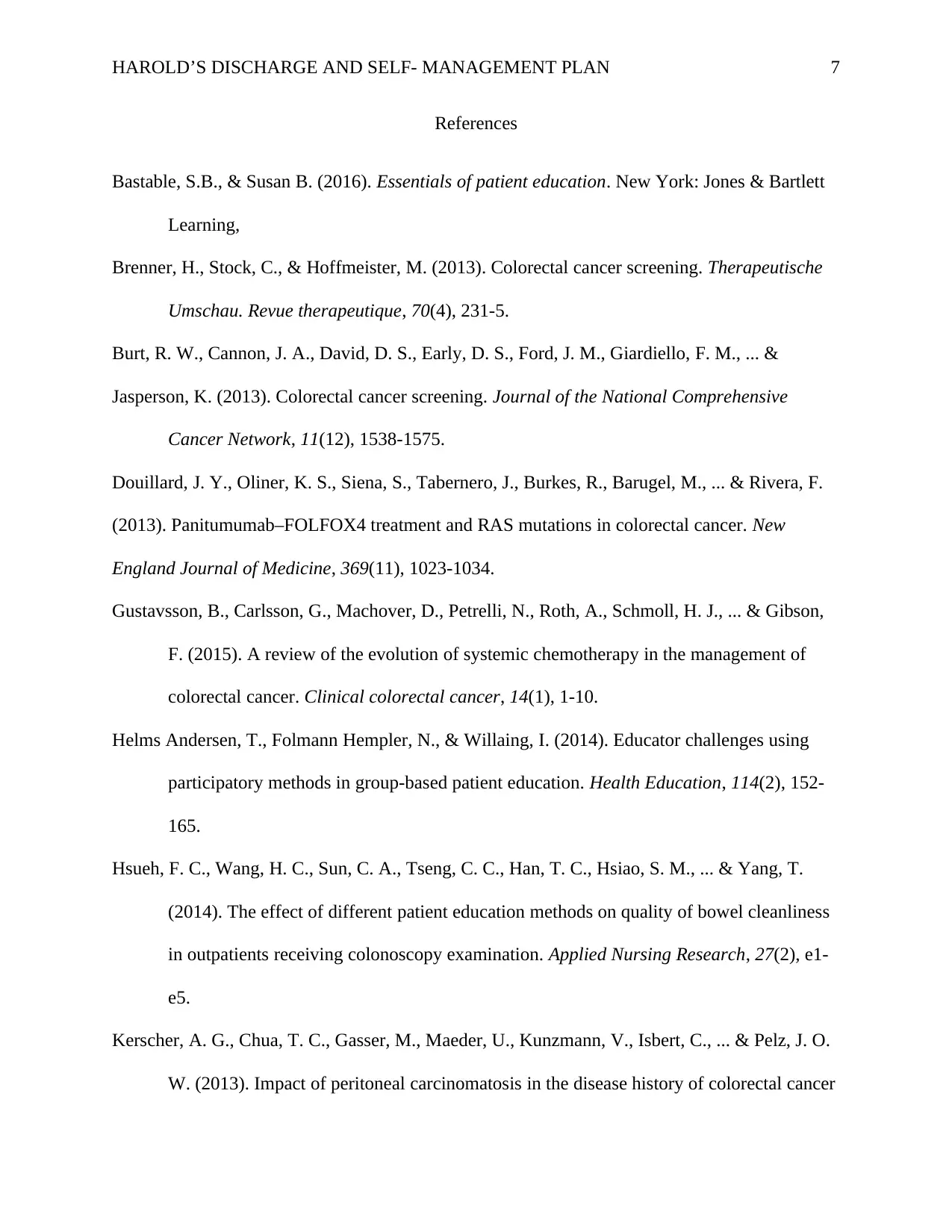
HAROLD’S DISCHARGE AND SELF- MANAGEMENT PLAN 7
References
Bastable, S.B., & Susan B. (2016). Essentials of patient education. New York: Jones & Bartlett
Learning,
Brenner, H., Stock, C., & Hoffmeister, M. (2013). Colorectal cancer screening. Therapeutische
Umschau. Revue therapeutique, 70(4), 231-5.
Burt, R. W., Cannon, J. A., David, D. S., Early, D. S., Ford, J. M., Giardiello, F. M., ... &
Jasperson, K. (2013). Colorectal cancer screening. Journal of the National Comprehensive
Cancer Network, 11(12), 1538-1575.
Douillard, J. Y., Oliner, K. S., Siena, S., Tabernero, J., Burkes, R., Barugel, M., ... & Rivera, F.
(2013). Panitumumab–FOLFOX4 treatment and RAS mutations in colorectal cancer. New
England Journal of Medicine, 369(11), 1023-1034.
Gustavsson, B., Carlsson, G., Machover, D., Petrelli, N., Roth, A., Schmoll, H. J., ... & Gibson,
F. (2015). A review of the evolution of systemic chemotherapy in the management of
colorectal cancer. Clinical colorectal cancer, 14(1), 1-10.
Helms Andersen, T., Folmann Hempler, N., & Willaing, I. (2014). Educator challenges using
participatory methods in group-based patient education. Health Education, 114(2), 152-
165.
Hsueh, F. C., Wang, H. C., Sun, C. A., Tseng, C. C., Han, T. C., Hsiao, S. M., ... & Yang, T.
(2014). The effect of different patient education methods on quality of bowel cleanliness
in outpatients receiving colonoscopy examination. Applied Nursing Research, 27(2), e1-
e5.
Kerscher, A. G., Chua, T. C., Gasser, M., Maeder, U., Kunzmann, V., Isbert, C., ... & Pelz, J. O.
W. (2013). Impact of peritoneal carcinomatosis in the disease history of colorectal cancer
References
Bastable, S.B., & Susan B. (2016). Essentials of patient education. New York: Jones & Bartlett
Learning,
Brenner, H., Stock, C., & Hoffmeister, M. (2013). Colorectal cancer screening. Therapeutische
Umschau. Revue therapeutique, 70(4), 231-5.
Burt, R. W., Cannon, J. A., David, D. S., Early, D. S., Ford, J. M., Giardiello, F. M., ... &
Jasperson, K. (2013). Colorectal cancer screening. Journal of the National Comprehensive
Cancer Network, 11(12), 1538-1575.
Douillard, J. Y., Oliner, K. S., Siena, S., Tabernero, J., Burkes, R., Barugel, M., ... & Rivera, F.
(2013). Panitumumab–FOLFOX4 treatment and RAS mutations in colorectal cancer. New
England Journal of Medicine, 369(11), 1023-1034.
Gustavsson, B., Carlsson, G., Machover, D., Petrelli, N., Roth, A., Schmoll, H. J., ... & Gibson,
F. (2015). A review of the evolution of systemic chemotherapy in the management of
colorectal cancer. Clinical colorectal cancer, 14(1), 1-10.
Helms Andersen, T., Folmann Hempler, N., & Willaing, I. (2014). Educator challenges using
participatory methods in group-based patient education. Health Education, 114(2), 152-
165.
Hsueh, F. C., Wang, H. C., Sun, C. A., Tseng, C. C., Han, T. C., Hsiao, S. M., ... & Yang, T.
(2014). The effect of different patient education methods on quality of bowel cleanliness
in outpatients receiving colonoscopy examination. Applied Nursing Research, 27(2), e1-
e5.
Kerscher, A. G., Chua, T. C., Gasser, M., Maeder, U., Kunzmann, V., Isbert, C., ... & Pelz, J. O.
W. (2013). Impact of peritoneal carcinomatosis in the disease history of colorectal cancer
Paraphrase This Document
Need a fresh take? Get an instant paraphrase of this document with our AI Paraphraser
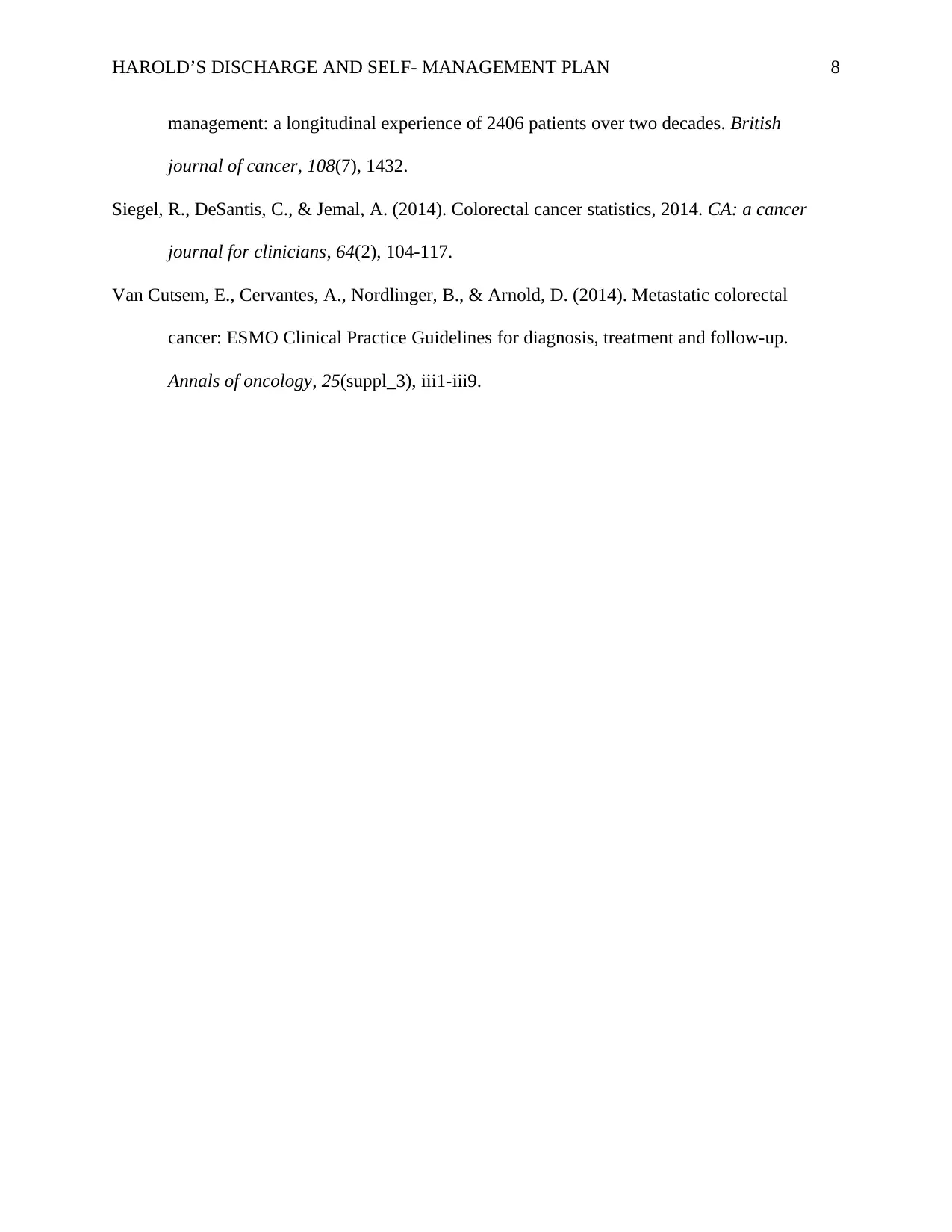
HAROLD’S DISCHARGE AND SELF- MANAGEMENT PLAN 8
management: a longitudinal experience of 2406 patients over two decades. British
journal of cancer, 108(7), 1432.
Siegel, R., DeSantis, C., & Jemal, A. (2014). Colorectal cancer statistics, 2014. CA: a cancer
journal for clinicians, 64(2), 104-117.
Van Cutsem, E., Cervantes, A., Nordlinger, B., & Arnold, D. (2014). Metastatic colorectal
cancer: ESMO Clinical Practice Guidelines for diagnosis, treatment and follow-up.
Annals of oncology, 25(suppl_3), iii1-iii9.
management: a longitudinal experience of 2406 patients over two decades. British
journal of cancer, 108(7), 1432.
Siegel, R., DeSantis, C., & Jemal, A. (2014). Colorectal cancer statistics, 2014. CA: a cancer
journal for clinicians, 64(2), 104-117.
Van Cutsem, E., Cervantes, A., Nordlinger, B., & Arnold, D. (2014). Metastatic colorectal
cancer: ESMO Clinical Practice Guidelines for diagnosis, treatment and follow-up.
Annals of oncology, 25(suppl_3), iii1-iii9.
1 out of 8
Related Documents
Your All-in-One AI-Powered Toolkit for Academic Success.
+13062052269
info@desklib.com
Available 24*7 on WhatsApp / Email
![[object Object]](/_next/static/media/star-bottom.7253800d.svg)
Unlock your academic potential
Copyright © 2020–2025 A2Z Services. All Rights Reserved. Developed and managed by ZUCOL.





